
Station Name: DAGGONS ROAD[Source: Nick Catford] Daggons Road Station Gallery 3: 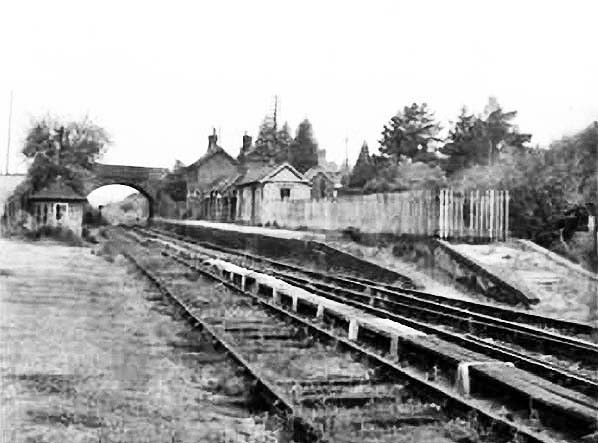 Daggons Road facing south-west a few months after closure. Everything would appear to be intact but track lifting operations would soon commence. At extreme left the steep slope which led down from the road to give road vehicle access to the loop siding can just be seen. The yhard on this side seems to have been mostly used for coal traffic but also once served cattle pens. Quite how horse-drawn road vehicles managed the slope back in the day is open to question.A better view of the access from the road is provided in another image. On the right can be seen the points leading to the Up side goods siding while the dock, behind the platform, appears to have been well and truly taken over by nature.
Photo from Alex North 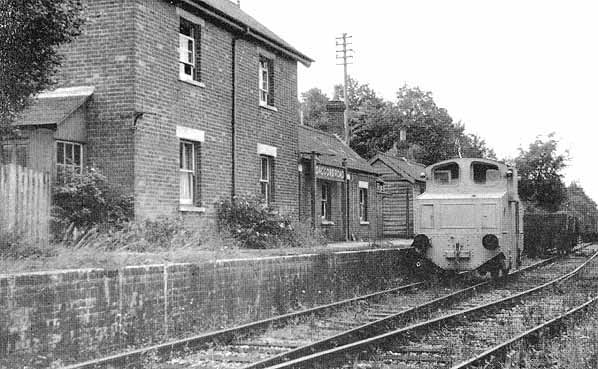 Closure had occurred in May 1964 and in 1965 track lifting was underway. Here we see the contractor's locomotive and a couple of wagons stabled at Daggons Road, probably over a weekend. The procedure varied but generally went as follows. Dismantling was usually put out to competitive tender and often the winner was one of the larger firms such as T.W. Ward and George Cohen. The contractor often had his own locomotives, as here, otherwise a BR train would be involved with the contractor hired only for the dismantling. The contractor's locomotive would be taken to the work location, usually by road. The contractor would move along the line as track and other materials were lifted into the wagons; when fully loaded the train would depart for a point where wagons would be removed by BR, who would replace them with empty wagons, or unloaded for onward movement of materials by road. The train would then return to the work location and the process repeated. At the end of each days work and at weekends the contractor's locomotive would run to a convenient stabling point, wagons usually being left at the point which dismantling had reached. The wagons seen here at Daggons Road are four-wheel open types, suggesting track was being cut up for scrap on site or at this point in time other materials were being removed. Lamps and signs have already gone but the running-in board still remains. The locomotive is a product of what originally called itself the "Motor Rail & Tram Car Company", better known by its trade name "Simplex". Simplex became famous for its narrow gauge internal-combustion rail tractors of the First World War and the company went on to produce cheap, basic locomotives for light industrial use although some found their way to the main line railways and ultimately into British Railways service. By Simplex standards the example seen here was relatively 'upmarket', having electric start (most Simplex machines required hand cranking), electric lighting and visors on each windscreen. This model harked back to 1923 and probably originally had a White & Poppe engine, a type which proved notoriously unreliable. Various makes of engine were subsequently fitted. The engine, coupled to a Simplex three-speed gearbox, was in the cab but to one side. The driver sat sideways with the cooling radiator behind him and an enormous clutch pedal in front of him, therefore only one cab door was provided. The bonnets at each end of this particular locomotive model contained batteries and sand boxes. Braking was by hand operated screw. Weight was quoted as being 16 tons. Simplex locomotives were never noted for their power. This particular model, which for some reason was never very popular, managed just 65hp which was actually quite high by Simplex standards. This level of power was nevertheless adequate for moving a few wagons at very low speed, which is all Simplex intended them to do. Numerous Simplex locomotives of various types and gauges survive today but only one example of the type seen here is known to exist, currently (2020) unrestored at the Foxfield Railway.
Photo from JM Ladd collection 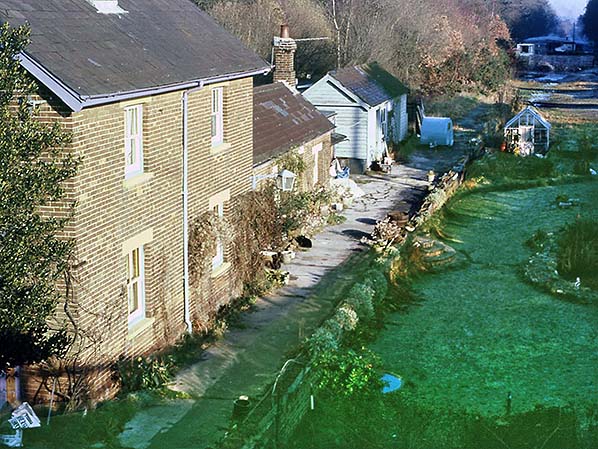
In August 1980 Daggons Road station is seen looking north west from the road bridge. The noth end of the platform has been removed to provide acces to the track bed where some buildings are now seen. The booking office and ladies waiting room survive with the track now converted into a gardeen for the station house.
Photo
by Nick Catford
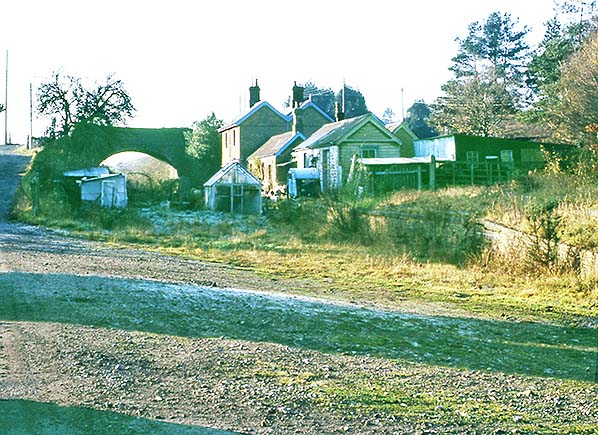 Daggons Road statiuon seen from the track in August 1980. The gents' toilet between the booking offic and ladies room has been removed and replaced with a new building. Daggons Road statiuon seen from the track in August 1980. The gents' toilet between the booking offic and ladies room has been removed and replaced with a new building.Photo by Nick Catford road7.jpg) On a bright spring day in April 1976 the garden at Daggons Road is in full bloom in this delightful view from Station Road bridge. On a bright spring day in April 1976 the garden at Daggons Road is in full bloom in this delightful view from Station Road bridge.Photo by Alan Young road3.jpg)
In August 1980 Daggons Road station is seen looking north west from the road bridge. The noth end of the platform has been removed to provide acces to the track bed where some buildings are now seen. The booking office and ladies waiting room survive with the track now converted into a gardeen for the station house.
Photo
by John Mann
road6.jpg)
Looking south west along the track at Daggons Road station in August 1992.
Photo by Ben Brooksbank road7.jpg) Daggons Road station house and booking office seen from the road bridge in January 2008 before and redevelopment around the station had started.
Photo by Michelle Howe from her Flickr Photostream 
Looking south-west along Station Yard in December 2019. The road occupies the track bed though the station site. The station itself was to the right where the houses are seen. The furthest house is the station house. The track bed has been filled up to the level of Station Road and the bridge has been removed.
Photo by Steph Wilton  Looking north-east along the short station approach road in May 2020. The first house on the right is the twin gabled station master's house. The house went on to serve the goods yard The entrance on the left led to the brick and pottery works. The green sign on the gate says Surplus Stores selling bankrupt stock. In the 1960s the stores was built around the old kilns but these were eventually demolished leaving just new prefabricated buildings. The site was for sale in 2006 and all buildings have now been demolished.
Photo by Steph Wilton 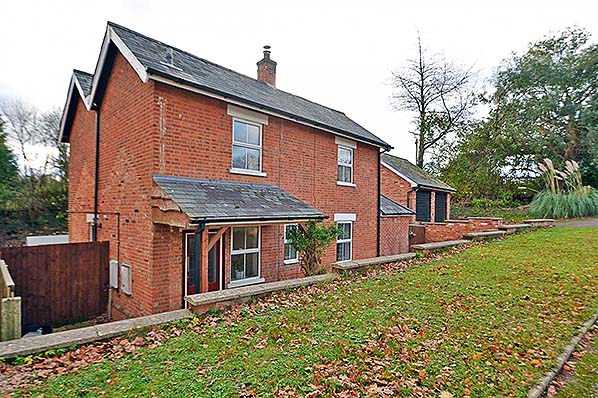
The station house in May 2020. The footrprint of the former station buildings (Booking office) which abutted it is clearly seen on te wall to the left. Strangely the new house on the left is called The Old Waiting Room. The building occupies part of the site of the old waiting room which together with the booking office were in the single storey block at the north end of the station house.
Photo by Steph Wilton 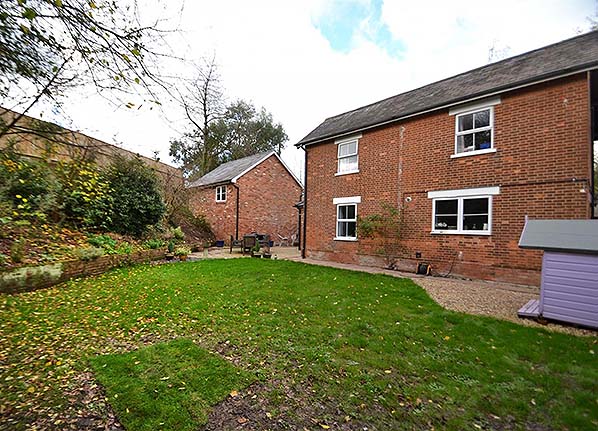
The rear garden of the station house in December 2019. The platform passed infront oif the building and the line ran under the road which is behind the fence on the left. All evidence of the platform and the bridge has now been removed. The house has been modernised with a new roof and new windows.
Photo by Steph Wlton 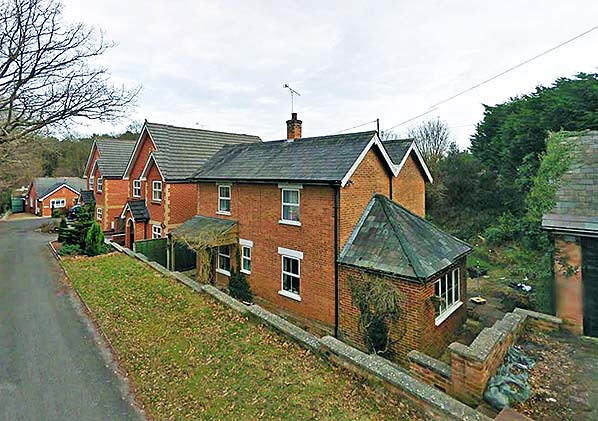
Looking north-east along the station approach road in December 2019. The station house survives, largely unaltered externally. The single storey station buildings and goods dock have been swept away to make way for new housing.
Photo by Steph Wiltpn
 Home Page Home Page
|
road4.jpg)
road5.jpg)
